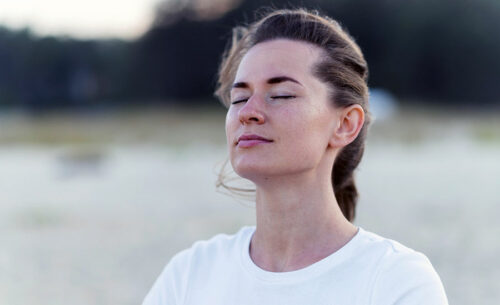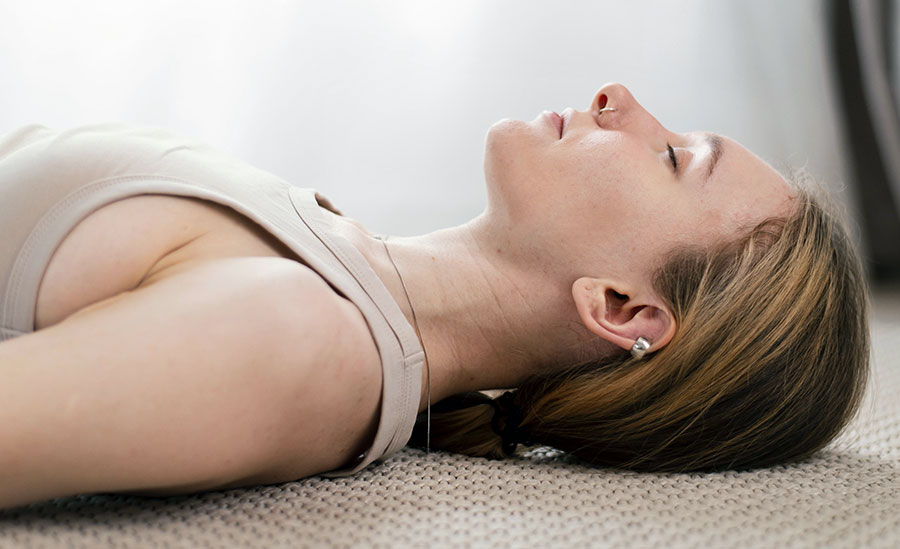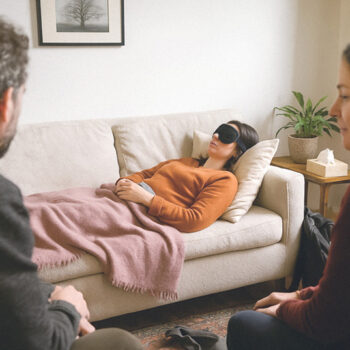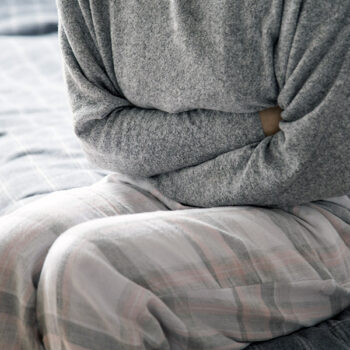The effects of breathwork on health

Breathing is the fundamental act of life. Whether you’re a workaholic, a heavy sleeper, or a Netflix addict, it’s the activity we do the most. Yet, stress, a sedentary lifestyle, and pollution have caused us to lose the instinct to breathe properly. However, effective breathing promotes good physical and mental health. Breathwork is a technique that leverages the neurochemical effects of breathing to reach altered states of consciousness, similar to psilocybin, triggering psychological reactions that are usually inaccessible—whether they are surreal, revealing, inspiring, or overwhelming. Moreover, it’s legal worldwide, and its effects on stress, anxiety, and depression are scientifically validated.
Breathwork: What is it?
Breathing in and out—most of us know how to do it. But achieving a deep sense of awakening through the airflow entering and leaving the lungs is more challenging. Unfortunately, it’s not enough to breathe like a high-pressure leaf blower to experience transcendent mental health effects. Ancient practices, honed over centuries, are required.
The essence of breathwork comes from a sophisticated blend: a rhythm, sequences, an atmosphere of light or music, and guidance. Depending on the facilitator’s preferences, this guidance can feel more like sports coaching, a shamanic ritual, or a comforting, attentive presence. In most methods, the facilitator plays a key role, as their expertise is what makes the mental journey possible.
Breathing to Stimulate Neurons
A session of intense breathing resembles a form of respiratory yoga that gradually intensifies. This type of exercise can be found in ancient practices like Indian Pranayama, a discipline of controlling vital energy.
With music, a facilitator alternates between phases of deep, regular, slow, or fast breaths, but most importantly, intentional breaths. You’ll breathe more than you need to. After several minutes, the effects of breathwork can become spectacular. Whether it’s Holotropic Breathing, Lion’s Breath, or Rebirthing Breathwork, each can produce effects you wouldn’t think possible through such natural means.
Indeed, with specific techniques of controlled breathing, you can increase oxygenation in the brain and alter its function. This stimulation enhances neuronal connectivity, as if you’re extending the range of an antenna that can now communicate more effectively with others.
A Breath to Unlock Consciousness
Thanks to this boosted conversation between neurons, you can, in a sense, break down the walls of your own consciousness and connect ideas that were previously unrelated or barely linked. These are the famous altered states of consciousness.
Breath by breath, the depth of the experience makes you forget the group, each person immersed in their own emotion. As the breathing sequence intensifies, it allows you to feel repressed emotions or identify unresolved traumas, which is where breathwork can impact mental health.
Most participants reach trance-like states, similar to a psychedelic trip. This is especially true with Holotropic Breathwork.

Different Methods for Different Effects
There are several types of techniques, each with its own characteristics. Some focus on relaxation, while others aim for what could be described as therapeutic outcomes.
Pranayama, the Ancient Method
Pranayama, a yogic breathing control technique, regulates vital energy (prana in Sanskrit) through patterns of inhalation, retention, and exhalation. Focused on relaxation, these exercises can purify the mind, improve concentration, and balance the nervous system. It’s often used to calm the mind and harmonize the body. Pranayama is also employed to prepare the mind for meditation and enhance focus before a challenge or effort.
Lion’s Breath (Pranayama Simhasana)
Lion’s Breath, or Simhasana Pranayama, is a yoga technique derived from Pranayama. Imitating the posture and attitude of a lion, you exhale loudly with your mouth wide open and tongue out.
Unique for its theatrical aspect, it aims to release tension from the face, throat, and chest. By mimicking the roar of a lion, this traditional breathing technique taps into simple psychological triggers: Lion’s Breath boosts self-confidence, stimulates circulation in the throat and face, and helps reduce stress and anxiety.
Holotropic Breathwork
Developed by psychiatrist Stanislav Grof, Holotropic Breathwork is one of the most intense methods. It seeks to reproduce the effects of a psychedelic trip without the use of psychoactive substances.
This Holotropic Breathwork involves rapid, deep breathing through the mouth, accompanied by mystical, intoxicating music. Often used in therapeutic settings, it helps develop self-awareness, revealing traumas or fostering profound inner transformation.
Psychotropic Breathing
Psychotropic Breathing is a program developed by Tangerine Retreat for use in their retreats. Its goal is to reach psychedelic trance states without consuming even a single dose of magic mushrooms. To achieve this, participants alternate between intensive and deep phases according to a precise rhythm. Psychotropic breathing is practiced with shoulders firmly anchored to the ground, fists and feet clenched and then gradually relaxed, guided by a facilitator.
The manifestations arise after 30 to 40 minutes: tears of emotion, a sense of peace, euphoria, or colorful visions.
Rebirthing Breathwork
Rebirthing Breathwork, created by Leonard Orr in the 1970s, relies on continuous nasal breathing without pauses for one to two hours. Unlike Holotropic Breathwork, which offers participants more autonomy, the facilitator’s presence is more involved in Rebirthing Breathwork to help maintain the steady rhythm throughout the session.
The main goal remains quite similar: to help participants release repressed emotions and achieve a sense of emotional and spiritual rebirth.
4-7-8 method
Developed by Dr. Andrew Weil, the 4-7-8 breathing method is now very popular in relaxation and hypnosis circles. Very simple, yet highly effective, it involves:
- Inhaling for 4 seconds,
- Holding your breath for 7 seconds,
- Exhaling for 8 seconds.
- You extend the exercise for at least six minutes.
By expanding the airways, this method activates the parasympathetic nervous system, which regulates stress responses. According to its practitioners, it promotes sleep, helps manage anxiety, and improves concentration.
The Effects of Breathwork on Mental Health: What Science Says
.We can’t cover all the variations of this fruitful discipline, but what’s certain is that breathwork is now regarded as a powerful therapeutic tool. The benefits of breathwork are beginning to be confirmed by scientific studies.
Breathwork for Depression
Research on controlled breathing shows that this practice can affect the nervous system and psychological well-being.
For instance, a study published in 2017 in the Journal of Clinical Psychiatry examined the effect of conscious breathing on depression symptoms over a 12-week protocol. By the end of the experiment, there was a 75% reduction in symptoms, even in patients resistant to conventional antidepressants. Breathwork could complement other therapies for depression.
The Effect of Breathing on Anxiety
Une autre étude sur l’anxiété, datée de 2023, compare l’efficacité de brèves séances de breathwork et de mindfulness (méditation de pleine conscience). Et bonne nouvelle : ces deux méthodes se sont montrées efficaces pour améliorer l’humeur des participants (évaluée en moyenne à avant le début de l’étude)
- Humeur avant le début de l’étude : ~1.25 points.
- Moyenne du “Groupe Mindfulness” après l’étude : 3.03 points.
- Moyenne du “Groupe Respiration contrôlée” après l’étude : 3.70 points
Another study on anxiety, published in 2023, compared the effectiveness of brief breathwork sessions and mindfulness (meditation). The good news: both methods proved to be effective in improving participants’ moods, which were assessed before the study.
- Mood before the study: ~1.25 points.
- Average for the “Mindfulness Group” after the study: 3.03 points.
- Average for the “Breathwork Group” after the study: 3.70 points.
Breathwork in retreats
Breathwork is a powerful ally for any kind of retreat. During a modified consciousness retreat, the expert, structured practice of breathwork sessions offers rich inner sensations and growth opportunities. In this type of setting, multiple sessions are arranged to help participants get familiar with the technique and gradually achieve more significant effects. The more you focus on proper breathing, the more apparent the results.
In psilocybin or ayahuasca retreats, breathwork is used to enhance the trip. Before taking the substance, its role is to prepare the mind for the psychedelic experience. After the spiritual journey, breathwork helps integrate the experience by allowing emotions to resurface.
Regardless, controlled breathing exercises are closely linked to the idea of personal exploration that is intrinsic to psychedelics.
Is breathwork psychedelic ?
The term psychedelic comes from ancient Greek and means “to elevate the soul or consciousness.” This aligns perfectly with breathwork’s goals. Therefore, we can say that breathwork is psychedelic. The altered states of consciousness it induces are very similar to those experienced under the influence of psychedelic substances like LSD: ego dissolution, visions, connection to a higher level of consciousness… Breathwork is a legal, safe, and accessible way to have a psychedelic experience without substances.
How does it differ from a substance-induced trip?
It’s similar but different… and it all depends on the individual! Each journey opens a door to an unknown world and unleashes emotions in an inner roar that can be tamed.
It’s like comparing Smells Like Teen Spirit (Nirvana) or Born to Be Wild (Steppenwolf) to Stairway to Heaven (Led Zeppelin) or Shine on You Crazy Diamond (Pink Floyd). All these songs carry a deep metaphysical energy, but their power resonates differently with each listener.
Which type of trip should you choose?
Breathwork is an ideal option for those who want to:
- Maintain a sense of control (you can stop the process within seconds);
- Recreate the methods at home after the retreat;
- Experience a legal adventure anywhere, with no major medical contraindications.
A psilocybin trip is a bolder choice. It’s suited for people who want to:
- See fast, tangible results in addressing personal issues;
- Embark on a memorable journey with deep symbolic meaning;
- Explore all facets of their consciousness in an amplified version;
- Commit fully to the integration process after the experience.
Finally, one of the key differences is the law. Breathwork is legal everywhere, while the legal status of psilocybin limits psychedelic retreats to the Netherlands.
Image from freepikLast updated on 6 October 2025





